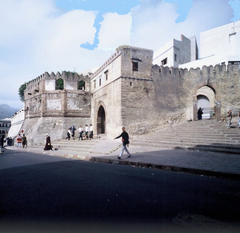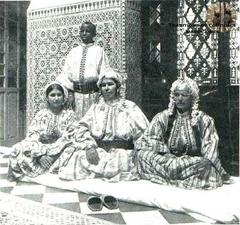Tamuda Visiting Hours, Tickets, and Historical Sites in Tétouan, Morocco
Date: 14/06/2025
Introduction
Just outside the vibrant city of Tétouan in northern Morocco lies the Tamuda Archaeological Site—a unique window into the region’s ancient Maurétanian and Roman heritage. Established between the 3rd and 2nd centuries BCE, Tamuda flourished as a Berber city-state before becoming a significant Roman outpost. Today, Tamuda’s well-preserved ruins, set along the Oued Martil valley and near the Mediterranean coast, offer visitors a rich historical experience, blending archaeological discoveries with the cultural vibrancy of modern Tétouan (e-services.minculture.gov.ma; yabiladi.com).
This comprehensive guide details Tamuda’s history, practical visitor information (including hours, tickets, and accessibility), archaeological highlights, and travel tips. It also explores the connection between Tamuda and Tétouan’s broader heritage, and includes recommendations for nearby attractions and seasonal events. Whether you’re a history enthusiast, traveler, or student, this guide will help you plan a memorable visit to one of northern Morocco’s most significant archaeological sites (Rough Guides; Moroccan Scene).
Contents
- Introduction
- Tamuda’s Historical Overview
- Foundation and Maurétanian Era
- Roman Conquest and Transformation
- Decline and Rediscovery
- Visitor Information
- Hours, Tickets, and Accessibility
- Guided Tours and Events
- Archaeological Highlights
- Nearby Attractions
- Tamuda Bay: Modern Leisure and Recreation
- Practical Travel Tips
- Cultural Etiquette
- Frequently Asked Questions (FAQ)
- Conclusion
- Sources
Tamuda’s Historical Overview
Foundation and Maurétanian Era
Tamuda was established between the 3rd and 2nd centuries BCE by Berber Mauritanians. Its location at the foot of the Ghomara mountains and along the Oued Martil provided both natural protection and access to fertile lands and trade routes. Ancient historians such as Pliny the Elder referenced Tamuda, underscoring its regional importance prior to Roman intervention (e-services.minculture.gov.ma).
Roman Conquest and Transformation
In the 1st century CE, Tamuda was incorporated into the Roman province of Mauretania Tingitana. The Romans established a military camp and administrative center on the site, introducing Roman urban planning, architecture, and coinage. Excavations have revealed the foundations of barracks, storage buildings, and sections of defensive walls. Tamuda’s Roman phase lasted until the 5th century CE, after which the site declined, possibly due to shifting trade patterns and the fall of the Western Roman Empire (quid.ma).
Decline and Rediscovery
After abandonment, Tamuda faded from local memory until it was rediscovered in 1921 by Spanish researcher César Luis de Montalban. Systematic Moroccan-led excavations have been ongoing since the 1990s. The site officially opened to the public in 2013, following restoration and conservation efforts (e-services.minculture.gov.ma).
Visitor Information
Tamuda Archaeological Site: Hours and Tickets
- Opening Hours: Daily, 9:00 AM–5:00 PM
- Closed: Mondays and national holidays (except Fridays, when Moroccan nationals may enter free of charge)
- Tickets:
- Adults: 30 MAD
- Students/Seniors: 15 MAD
- Moroccan nationals: Free on Fridays and national holidays
- Tickets are available at the entrance or online (e-services.minculture.gov.ma).
Accessibility
Marked walking paths and some ramps have been added for visitors with mobility challenges, though much of the terrain remains uneven due to the site’s archaeological nature. It is recommended to wear sturdy, comfortable shoes.
Guided Tours and Special Events
Guided tours in Arabic, French, and English are available through the Ministry of Culture or local operators. Workshops and cultural events are often scheduled during summer and festival seasons to enhance the visitor experience (Moroccan Scene).
Archaeological Highlights
- Maurétanian Remains: Explore original Berber-era residential structures, defensive walls, and artisanal workshops.
- Roman Military Camp: Visit the foundations of Roman barracks, administrative buildings, and urban infrastructure.
- Artifacts: Nearby, the Tétouan Archaeological Museum displays notable finds from Tamuda, including coins, ceramics, bronze tools, and a famed Roman mosaic of the Three Graces (medirocrent.com).
- Site Area: Spanning approximately 5 hectares, Tamuda is among the largest ancient sites in northern Morocco.
Nearby Attractions
- Tétouan Medina: A UNESCO World Heritage site, minutes from Tamuda, featuring Andalusian architecture and bustling souks.
- Tamuda Bay: A modern resort area with luxury hotels, private beaches, spas, and a variety of water sports (travelnoire.com; Dardif).
- Talassemtane National Park: Hiking and nature activities in the Rif Mountains.
- Chefchaouen: The “blue city,” easily reached as a day trip from Tétouan.
Tamuda Bay: Modern Leisure and Recreation
Tamuda Bay, named after the archaeological site, is a contemporary resort district offering high-end accommodations, golf courses, marinas, and a wide array of leisure activities. The bay is known for its clean beaches, clear Mediterranean waters, and family-friendly amenities such as water parks and kids’ clubs (Dardif).
Activities include:
- Beach relaxation and water sports (jet-skiing, windsurfing, diving)
- Birdwatching at the Smir Lagoon
- Spa and wellness treatments
- Dining, shopping, and nightlife
Practical Travel Tips
- Getting There: Tamuda is about 5 km from central Tétouan; taxis and local buses are readily available. The N16 highway connects Tétouan, Tamuda, and Tamuda Bay.
- Best Time to Visit: Spring (April–June) and autumn (September–October) offer the most pleasant weather and fewer crowds. Summer (July–August) is peak tourist season.
- What to Bring: Comfortable walking shoes, sun protection, and water.
- Facilities: There are no restrooms or cafes at the archaeological site; plan accordingly.
Cultural Etiquette
- Dress modestly, especially when visiting historical or religious sites.
- Always ask permission before photographing locals.
- Greet people with “Salam Alaikum.”
- Respect the site by not climbing on or removing artifacts; drone use requires permission.
Frequently Asked Questions (FAQ)
Q: What are Tamuda’s visiting hours?
A: Open daily from 9:00 AM to 5:00 PM (closed Mondays).
Q: Where can I buy tickets?
A: At the entrance or online via the Ministry of Culture’s website.
Q: Is Tamuda accessible for people with disabilities?
A: Some pathways are accessible, but much of the terrain is uneven.
Q: Are guided tours available?
A: Yes, in Arabic, French, and English; advance booking is recommended.
Q: What should I bring?
A: Comfortable shoes, water, sun protection, and a camera.
Q: What else can I visit nearby?
A: Tétouan Medina, Tamuda Bay, Talassemtane National Park, and Chefchaouen.
Conclusion
Tamuda is a remarkable testament to Morocco’s ancient Maurétanian and Roman past, offering visitors a fascinating journey through centuries of cultural transformation. Its proximity to Tétouan and Tamuda Bay makes it an ideal addition to any northern Morocco itinerary. By respecting local customs, planning your visit during optimal seasons, and taking part in guided experiences, you’ll deepen your understanding of the region’s enduring heritage.
To stay up to date with opening hours, ticket information, and special events, download the Audiala mobile app. Explore related articles on Tétouan’s medina, Moroccan travel tips, and historical sites, and follow us on social media for more inspiration.

